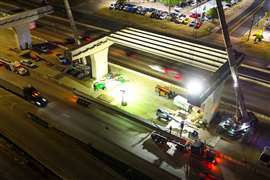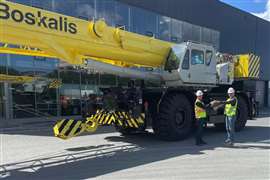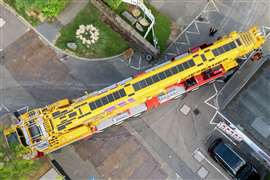Gangbusters? Not quite yet
06 January 2014
.jpg)
The plan is working. Mammoet’s global excellence in heavy lifting and transporting arrived on the U.S. West Coast only about a year ago. The company’s business there continues to step forward smartly.
“I wouldn’t say we’re going gangbusters in the Pacific Coast states, but things are looking good for us,” reported Jim Hamilton. He’ is the branch manager in Vancouver, WA, where Mammoet maintains one of its key locations in the west.
“Our typical lead time at Mammoet is 24 months,” Hamilton said. “But looking only at 2014, it appears to be positive for us. Refining looks very strong in California and the Pacific Northwest. Mining looks like it will take off in New Mexico, Utah and a little bit in Wyoming.”
Mammoet draglines are essential in those projects.
“We also expect to do lots of projects in power generation,” Hamilton added. “Our company would regularly go to the Pacific Coast for individual projects. But we never had a (sustained) presence there. Now we’re working closely with our Canadian (Mammoet) brethren to keep moving forward.”
One of those leaps came when Mammoet created four 250-ton-capacity dolly trailers to meet requirements for transporting on California highways. The company made axles to strict specifics and also had them fit with special tires.
“The trailers are very expensive, but they’ve been great for our business,” Hamilton said. “They’ve given us a big advantage for doing business in California. The advantage is that nobody else has anything like them.”
No guesswork
Omega Morgan likes to say it “takes the guesswork out of even the most complicated jobs.”
The company’s Sellwood Bridge project in Oregon certainly counted as a complex job. An Omega Morgan crew jacked up, then moved, the 1,100-foot, 6.8 million-pound bridge.
Most projects make smaller demands on the company’s Portland, Seattle and Phoenix locations. They will keep coming steadily, according to John McCalla, Omega Morgan’s president and CEO.
“We expect 2014 growth to be in the high single digits,” McCalla predicted.
Omega Morgan neatly balances the skills of its 250 employees to broaden services. Those services include machinery moving, heavy lifting and heavy transportation.
A diverse customer base also helps the company reach that high single-digit growth. Omega Morgan serves Boeing, other manufacturers, construction and several high-tech companies.
“We also expect our energy business to expand in 2014,” McCalla said. “Gas. Hydroelectric. Nuclear. Wind. We have expertise not only in lifting heavy equipment, but in moving it to where it needs to be in a building. The key to increasing our business is that we continue to demonstrate we have what it takes to get the job done.”
Bursts of momentum
Bigge Crane and Rigging entered 2014 with bursts of momentum from success with two high-profile projects.
Bigge’s crane services were invaluable in the $6-billion upgrade of the San Francisco-Oakland Bay Bridge, which reopened in September.
Bigge also performed all follow-up lifting after July’s Asiana Airlines crash at San Francisco’s airport.
Bigge Marketing Manager Ryan Parker expected public awareness of those two successful projects to benefit the company’s reputation.
“We did lifting and transferring on both projects,” Parker said. “Our people performed fantastically.”
The decade-long bridge project “earthquake-proofed” the structure, which connects San Francisco with Oakland.
The 1989 earthquake that claimed more than 60 lives took out two major sections of the bridge. Even if results are less fantastic than the bridge success, Parker anticipates a solid 2014 for his company.
Saying he could not be specific about expectations for the New Year, Parker speculated, “I would expect it to be a very good year for us. On our transportation side, we’re looking at a lot of pipeline work. On the crane side, we have a very large fleet. We’re looking at lots of projects for bigger cities.”
Bigge operates out of locations in six western states – Arizona, Utah, Washington, Nevada and Colorado, in addition to California. Including cranes at its Houston location, Bigge serves customers in the west with a fleet of about 550.
A new office should also boost Bigge’s service. The company maintains four locations in the San Francisco area. Now its new Los Angeles site is strengthening service in the state’s southern areas.
“That location has become an important extension of our (San Leandro) headquarters,” Parker said.
Las Vegas revival?
Dielco Crane also boasts a project surrounded by public view. The Las Vegas company helped erect the celebrated Las Vegas High Roller. Upon opening next spring, it will become the world’s tallest Ferris wheel. The wheel will top out at 550 feet, or 107 feet higher than Britain’s London Eye.
At the center of the Las Vegas “strip,” the High Roller will demonstrate flexibility in Dielco’s capabilities. The company relied on a Liebherr 1750 crawler for this project, supported by a Manitowoc 2250 as an access crane.
Despite struggles with Nevada’s wobbly economy, Dielco maintains a broad fleet. It includes tower cranes, crawlers up to 750 tons, conventional truck cranes up to 300 tons and hydraulic truck cranes up to 500 tons.
Now, to find work for them all.
After booming business in Las Vegas until 2006, Dielco owner Dick Dieleman said “the bottom dropped out.”
He said that Nevada’s prosperity slump pounded Dielco’s business down by 30 percent from its peak years.
“We once had about 250 people,” he said. “Now we’re down to about 100. It’s hard when you have to let people go who are like family members, who’ve been with you 15 years. The bank insists on paying back (loans), so that’s all we could do.”
For 2014, Dieleman anticipates improvement.
“I’m hopeful we can get back up to 45 percent of where we were in our best years,” he said. “We’ve added some cranes. Our customers like our newer cranes because they have lots of new features. Since our customers like those features, so do we.”
STAY CONNECTED


Receive the information you need when you need it through our world-leading magazines, newsletters and daily briefings.
CONNECT WITH THE TEAM











